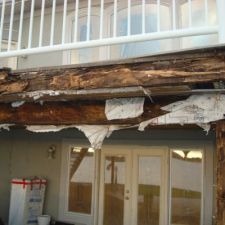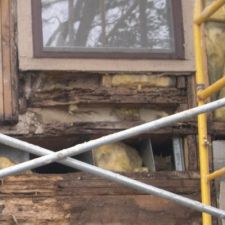Stucco Problems, Repair, & Maintenance

Balcony Showing Stucco Damage
Fort Collins, CO
Stucco Inspections & Defects
As a Home Inspector Certified in Stucco Inspections and moisture analysis for 6 years, I’ve seen hundreds of stucco clad homes with a multitude of defects in Fort Collins, Longmont, and other towns and cities up and down the Front Range of Northern Colorado.
In the majority of cases these defects result in moisture intrusion and damage to the substrate and/or framing.
Types of Stucco Systems
95% of the residential stucco in Northern Colorado is either:
- a “barrier” type system
- a “drainage” type system
Most EIFS (Exterior Insulation Finish System) stucco systems are the “barrier” type, which means that what you see is the primary weather barrier. When moisture enters behind the stucco, it becomes trapped and rots any moisture sensitive materials. Typically, the older the EIFS stucco is the more issues are discovered.
By far, the most important component of a barrier system is the sealant joints around all penetrations, including windows, doors and surface mounted fixtures. Proper flashings at roof/wall interfaces, decks and columns prevent moisture intrusion at those locations.
Traditional stucco, or 3 coat stucco is typically a “drainage” type, which means that if moisture enters behind the stucco, it hits a drainage plane, and drips out the bottom through a weep screed. The air space behind the stucco “breathes”.
“One coat” or “Hard coat” stucco can be either a barrier, or drainage type system. Most I see have no drainage plane, or weep screeds, at the bottom. When there is no visible gap between the water proofing and the stucco, then you have a barrier system without the benefit of exterior insulation.

Repairing Damaged Stucco Around Window – Longmont, CO
When Requirements Aren’t Met
All types of systems have required protection of the moisture sensitive substrate, prior to stucco application. Most have voids in this protection, particularly around windows, doors, roof/wall interfaces, deck ledger boards and deck support columns.
Older EIFS systems were often attached directly to the moisture sensitive substrate and often result in several areas of rot and microbial growth, inside the wall cavity.
Inspecting Stucco for Defects
Inspection methods include invasive probing to determine:
- the actual moisture content at the substrate
- the condition of the substrate
Be aware that infrared thermography has major limitations in detecting moisture behind an insulating barrier and cannot detect damaged substrate from prior leaks that are now dry.
Prevention is the Best Cure
The bottom line is that you need to maintain the entire stucco system, and as always THINK LIKE A DRIP.
Consider the fact that 99% of Home owner insurance policies completely exclude any coverage for moisture related damage.
You’re on your own when it comes to stucco problems and repair. Stucco maintenance is your best protection.
If you are in Fort Collins, Longmont, or surrounding areas, wanting to buy or sell a home and are concerned about the stucco, contact us for a home inspection (970) 567-7393.